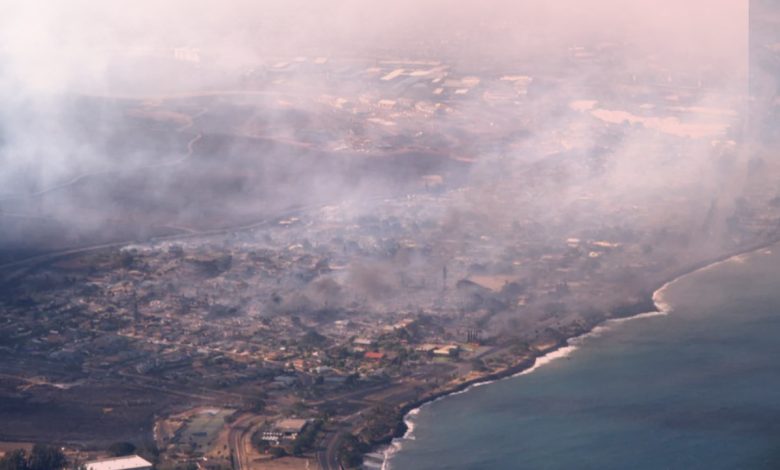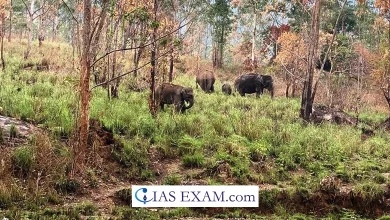Daily Current Affairs for UPSC
Wildfires in Hawaii
Syllabus:-Indian Polity, Features of the Indian Constitution

Context- Hawaii has several wildfires, especially on the islands of Maui and Lahaina.
What are wild fires?
- Wildfires are uncontrolled fires that spread quickly through vegetation such as forests, grasslands or brush.
- These flames can be started spontaneously, such as by lightning strikes, or intentionally by humans, such as fires, dropped cigarettes, sparks from appliances, or intentionally.
- A wildfire can be small and controlled, clearing brush and promoting healthy ecosystem processes, or it can be large and destructive, threatening human life, property and the environment.
Causes
-
- Natural causes: This includes volcanic activity and lightning. Maui is one of Hawaii’s six active volcanoes. Much of Maui was experiencing a severe drought, so dry, foreign grass and vegetation were ready to fuel the fires.
- Winds from Hurricane Dora: The Hawaiian fire started naturally and was carried by Hurricane Dora (a powerful storm in the Pacific). It mostly hit the islands, causing the fire to spread and making it difficult to control.
- Dry weather: This removes moisture from vegetation, which means it can catch fire more easily and then spread.
- Natural causes: This includes volcanic activity and lightning. Maui is one of Hawaii’s six active volcanoes. Much of Maui was experiencing a severe drought, so dry, foreign grass and vegetation were ready to fuel the fires.
- The role of fossil fuels: The burning of fossil fuels, which releases large amounts of greenhouse gases into the atmosphere, causing global warming.
-
-
- According to the United Nations, the number of wild fires worldwide will increase up to 14 percent by 2030, 30 percent by the end of 2050, and 50 percent by the end of the century.
-
- Anthropogenic Causes
-
- Human negligence: Most wildfires in the United States are caused by humans, including campfires, burning trash, equipment malfunction, and cigarette smoking.
- Agricultural expansion: Burning agriculture is a major factor in the global spread of wildfires.
- Poaching: Poachers often use fire to catch animals in many parts of the world.
- These fires can intensify and develop into wildfires.
Consequences
- Pollution: Air pollution from forest fires is more intense than other types of air pollution, although it usually occurs over a shorter period of time.
- Wildfire smoke is a complex mixture of fine and coarse particles and gases, including carbon monoxide, nitrogen oxides, volatile organic compounds and air toxins.
- Health hazards: Although fire poses an immediate threat to human life and property, wildfire smoke, and especially PM 2.5 particles, or particles less than 2.5 microns in size, can also affect the respiratory and cardiovascular systems.
- Those who already suffer from cardiovascular or respiratory diseases are at risk of worsening the disease.
- Wildlife: In addition to destroying vegetation (trees, grasses, meadows, plants, etc.) and their diversity, wildfires also have significant long-term negative effects on wildlife, including native endangered species.
- They affect wildlife by burning eggs, killing young animals and displacing adults from their habitats.
- Forest and soil: Forest fires destroy soil organic matter and expose topsoil to erosion.
- This also leads to loss of crops.
- They harm the regeneration of forests and their productivity.
- Economic: Forest fires can disrupt traffic, communications, electricity and gas services, and water supplies.
Prevention and mitigation of forest fires
- Precautions:
-
-
- Predicting fire-prone days using weather data.
- Cleaning the campsite from dried biomass.
- Early burning of dry litter on the forest floor.
- Cultivation of fire resistant plant species in the forest.
- Create fire lines in forests (strips in the forest that are kept away from vegetation to prevent fire from spreading).
- Controlled burns are also used to prevent wildfires.
- A controlled burn is a fire intentionally started by humans for a specific purpose.
- Well-planned and well-managed controlled burns can be incredibly beneficial to forest management because they can help stop wildfires from getting out of control.
-
- Relief:
-
- Early detection by firefighting units and quick action are critical.
- For such activities, forest departments have fire fighting and fire fighting unit.
- The best way to contain a forest fire is therefore to stop it from spreading, which can be done in the form of fire roads in the form of small trenches.





.png)



